Related Research Articles
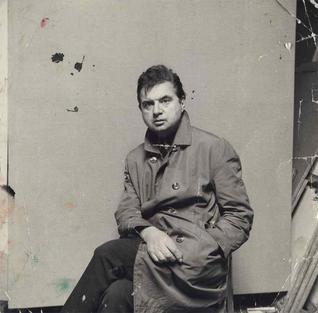
Francis Bacon was an Irish-born British figurative painter known for his raw, unsettling imagery. Focusing on the human form, his subjects included crucifixions, portraits of popes, self-portraits, and portraits of close friends, with abstracted figures sometimes isolated in geometrical structures. Rejecting various classifications of his work, Bacon said he strove to render "the brutality of fact." He built up a reputation as one of the giants of contemporary art with his unique style.

The Colony Room Club was a private members' drinking club at 41 Dean Street, Soho, London. It was founded and presided over by Muriel Belcher from its inception in 1948 until her death in 1979.

Kestner Gesellschaft is an art institution in Hanover, Germany, founded in 1916 to promote the arts. Its founders included the painter Wilhelm von Debschitz (1871–1948). The association blossomed under the management of Alexander Dorner and Justus Bier, pioneering modern art.
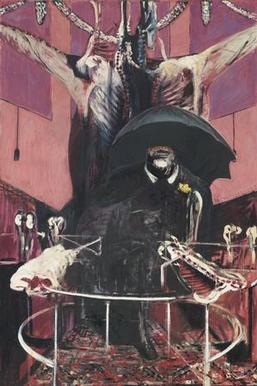
Painting 1946, also known as Painting or Painting (1946), is an oil-on-linen painting by the Irish-born artist Francis Bacon. It was originally intended to depict a chimpanzee in long grass ; Bacon then attempted to paint a bird of prey landing in a field. Bacon described the work as his most unconscious, the figurations forming without his intention.
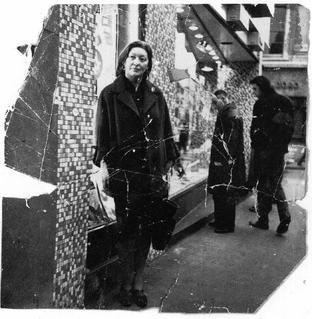
Isabel Rawsthorne, also known at various times as Isabel Delmer and Isabel Lambert, was a British painter, scenery and costume designer, and occasional artists' model. During the Second World War she worked in black propaganda. She was part of an artistic bohemian society that included Jacob Epstein, Alberto Giacometti and Francis Bacon.
Robert Melville was an English art critic and journalist. Along with the artists Conroy Maddox and John Melville, he was a key member of the Birmingham Surrealists in the 1930s and 1940s. An early biographer of Picasso, he later become the art correspondent of the New Statesman and the Architectural Review.

Bettina Shaw-Lawrence, also known as Betty Shaw-Lawrence, was an English figurative artist. Shaw studied painting and drawing under Fernand Léger, Cedric Morris and Arthur Lett-Haines, though she was mainly self-taught and worked professionally until the early 1980s.
Victor Arthur James Willing was a British painter, noted for his original nude studies. He was a friend and colleague of many notable artists, including Elisabeth Frink, Michael Andrews and Francis Bacon. He was married to Portuguese feminist artist Paula Rego.
Timothy John Behrens was a British painter who spent most of his professional life as a painter and a writer abroad, in Greece, Italy, and Spain.

Christo Coetzee was a South African assemblage and Neo-Baroque artist closely associated with the avant-garde art movements of Europe and Japan during the 1950s and 1960s. Under the influence of art theorist Michel Tapié, art dealer Rodolphe Stadler and art collector and photographer Anthony Denney, as well as the Gutai group of Japan, he developed his oeuvre alongside those of artists strongly influenced by Tapié's Un Art Autre (1952), such as Georges Mathieu, Alfred Wols, Jean Dubuffet, Jean Fautrier, Hans Hartung, Pierre Soulages, Antoni Tàpies and Lucio Fontana.
Head VI is an oil-on-canvas painting by Irish-born figurative artist Francis Bacon, the last of six panels making up his "1949 Head" series. It shows a bust view of a single figure, modeled on Diego Velázquez's Portrait of Innocent X. Bacon applies forceful, expressive brush strokes, and places the figure within a glass cage structure, behind curtain-like drapery. This gives the effect of a man trapped and suffocated by his surroundings, screaming into an airless void. But with an inverted pathos is derived from the ambiguity of the pope's horrifying expression—whose distorted face either screams of untethered hatred towards the viewer or pleads for help from the glass cage—the question of what he is screaming about is left to the audience.

Portrait of Isabel Rawsthorne Standing in a Street in Soho is a 1967 oil-on-canvas painting by the Irish-born English figurative artist Francis Bacon, housed in the Neue Nationalgalerie, Berlin. Described by art critic John Russell as one of Bacon's finest works, it depicts Isabel Rawsthorne, the painter, designer and occasional model for artists such as André Derain, Alberto Giacometti and Picasso.
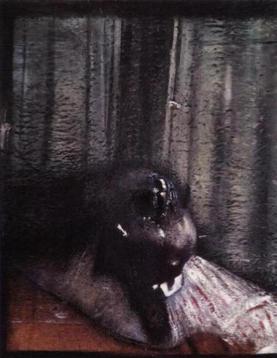
Head II is an oil and tempera on hardboard painting by the Irish-born British figurative artist Francis Bacon. Completed in 1948, it is the second in a series of six heads, painted from the winter of 1948 in preparation for a November 1949 exhibition at the Hanover Gallery, London.

Erica Brausen, was an art dealer and gallerist who established the Hanover Gallery in London in 1948. She was an early champion of several influential contemporary artists, most notably Francis Bacon.
Catharina "Toto" Koopman was a Dutch-Javanese model who worked in Paris prior to World War II. During that war she served as a spy for the Italian Resistance and was captured and held prisoner in the Ravensbrück concentration camp. She later helped establish the Hanover Gallery as one of the most influential art galleries in Europe in the 1950s.

Arthur Tilden Jeffress was an influential gallery owner, collector, and patron of the arts in post-World War II Britain. In the 1920s and 1930s he was conspicuous mostly as a rich playboy and socialite. He died in 1961, leaving his art collection to the Tate and Southampton City Art Gallery.
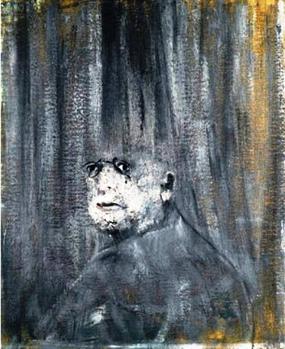
Head III is an oil painting by Francis Bacon, one of series of works made in 1949 for his first one-man exhibition at the Hanover Gallery, in London. As with the other six paintings in the series, it focuses on the disembodied head of male figure, who looks out with a penetrating gaze, but is fixed against an isolating, flat, nondescript background, while also enfolded by hazy horizontal foreground curtain-like folds which seems to function like a surrounding cage.

Head V is a 1949 painting by Irish-born British artist Francis Bacon, one of the series of works made in 1949 for his first one-man exhibition at the Hanover Gallery, in London. It measures 82 by 66 centimetres and is held in a private collection. The painting is part of a series of six works from the late 1940s depicting heads. Like Head II, the work depicts a distorted head in a space in a space shrouded with vertical bands interpreted as curtains, with several safety pins in the curtains.
Edward Michael Behrens was a British financier, banker, stockbroker, and restaurant and gallery owner, who became co-owner of the Ionian Bank. Through his ownership of the Hanover Gallery, he was an early patron of the artist Francis Bacon.

Two Figures (1953) is an oil painting by Francis Bacon, sometimes known as Two Figures on a Bed. It measures 152.5 cm × 116.5 cm, and is in a private collection.
References
- ↑ Summers, Cherith. "Erica Brausen and the Hanover Gallery (1948-1973)".
- ↑ see British and Irish Artists of the 20th Century, Hanover Gallery
- ↑ Peppiatt, Michael (2018). Francis Bacon: the Anatomy of an Enigma. London: Routledge. p. 179.
- ↑ Gill Hedley. "Arthur Jeffress for Painting". Gill Hedley. Retrieved 11 July 2017.
- ↑ Jean-Yves Mock sells art from the gallery in The Daily Telegraph, 10 January 2005
- ↑ Obituary: Erica Brausen in The Independent , 30 December 1992
- ↑ Summers, Cherith. "Erica Brausen and the Hanover Gallery (1948-1973)".